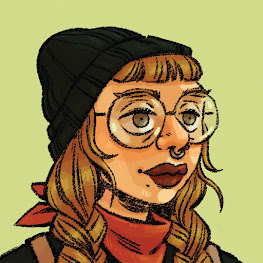Interview With Bree Paulsen, Author / Illustrator of The Firelight Apprentice

Welcome to Smack Dab, Bree! Please tell us a bit aboutThe Firelight Apprentice.
It’s a story following two sisters in a worldpost-war, mourning the loss of their mother while they seek a mentor for theyoungest sister so she can better control her magic.
I ’ m a writer who within the past couple of years gotback into art. My graphic novel reading has absolutely exploded in that time.Were you always a comic or graphic novel reader?
To a degree, definitely as much as I am now. I think Ialways wanted to read comics when I was young, but jumping into it always feltdaunting back then as there weren’t as many outlets outside of collecting capecomics. I grew up in a household that had books about comics around, like Howto Draw Comics the Marvel Way by John Buscema and Stan Lee, but mostof my comic reading came from comic sections in kids’ magazines and a couplerandom volumes of manga I picked up at book fairs.
How do you plot out your books? A graphic novel issuch an enormous undertaking, and yours is rich with so many themes – the impact of war,finding your place in the world, the binds of family …
From the concept, I will beat out the story with anoutline before expanding that into a script. Though, The FirelightApprentice is a special case that is based on a dream so I had the basicbeats of the story from the start; I just had to work them into a narrativethat made more sense, fleshing out the world-building in the process and thespecific themes I explore.
What comes first, character sketches or an idea for astory?
Usually I have an idea first for a story, butsometimes I’ll start drawing a character and a story will start to form aroundthem. This was the case with Garlic from my debut graphic novel, Garlic andthe Vampire.
What are your favorite tools?
The Photo Booth app on my computer. It helps so muchwhen I am struggling to find reference for a pose or hand position. 3D modelingprograms like Blender are also extremely handy for working out an environmentor when I need to turn a prop in space.
I feel like one of your greatest strengths as anartist is in facial features and expression. Often, I felt like we got anentire page of exposition in one panel / closeup – how do you approachfacial drawing?
This is definitely my animation education coming outto shine. I had to learn how to act through my drawings when animating and ithas helped so much in making sure expressions are just right on a page.
I also loved your action scenes. How do you makeaction make sense in static images? How do you make it appropriate for youngerreaders?
I’m glad you like the action scenes. I feel that iswhere I could improve upon the most. I basically pored over some of my favoritemanga and comics for how they handled motion and explosions.
One of the draws to children ’ s books, I think, is the way they just bubble overwith magic. In your book, magic is far more than a metaphor. But you make sureto depict that magic is delightful but also dangerous – I loved that it wasplaced side-by-side with electricity (the father ’ s bulb store). Can you speak to this a bit, and whyyou presented magic this way in an MG?
It feels weird to say that it just makes sense? Iguess I approached magic from a realistic way, seeing how it would be harnessedin the day-to-day, but also by those who hold power. Like of course if magicwas real, it would be used as a power source, and of course, it would beweaponized and used in war.
Drawbacks were also important. I didn’t want magic tobe this thing that could solve all problems. Being someone who could conjure itneeded to be sort of a blessing and a curse, which is what we see with Safi andher “growing pains.” Adding these complexities makes the story more interestingand gives finding a mentor for Safi higher stakes, because she couldaccidentally blow something up or make her a lure for a lich, but also themagic will physically hurt her if she is not given proper outlets.
I ’ ll admit, this was the first time I ’ d ever heard of a lich. (This is a bit embarrassing,but I Googled it to see if it was something you had invented or part of a kindof larger folklore.) It does offer kind of the perfect antagonist in a story ofmagic. What did you hope that young readers would take from the depiction ofthis antagonist?
Like you mentioned earlier, magic in this story ismetaphorical. Sometimes there is an aspect of yourself that others will preyupon, and who those predators are may not be obvious at first.
What do you hope young readers take from The FirelightApprentice, more than anything?
The importance of bonds and community, especially inscary times like these. We have to look after one another, and stand up againstpowers that wish to exploit and belittle.

What ’ s next?
I’m currently working on a YA adaptation of Draculathat is from Mina’s point of view. It has been a challenging project, but I’mvery eager to share it once it’s done.
Where can we find you?
I am @ breebird33 on most of social media these days,most active on Bluesky. I also have my website vampiresnwhimsy.com which I update somewhat regularly, including upcomingbook events.



